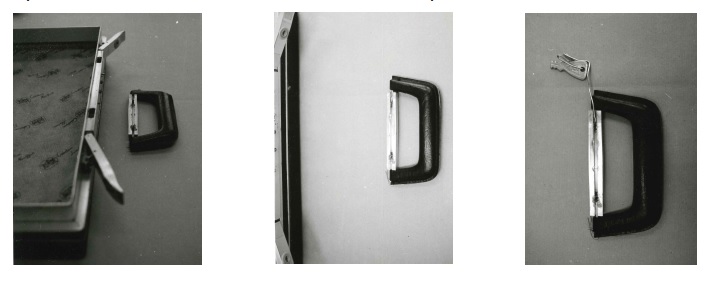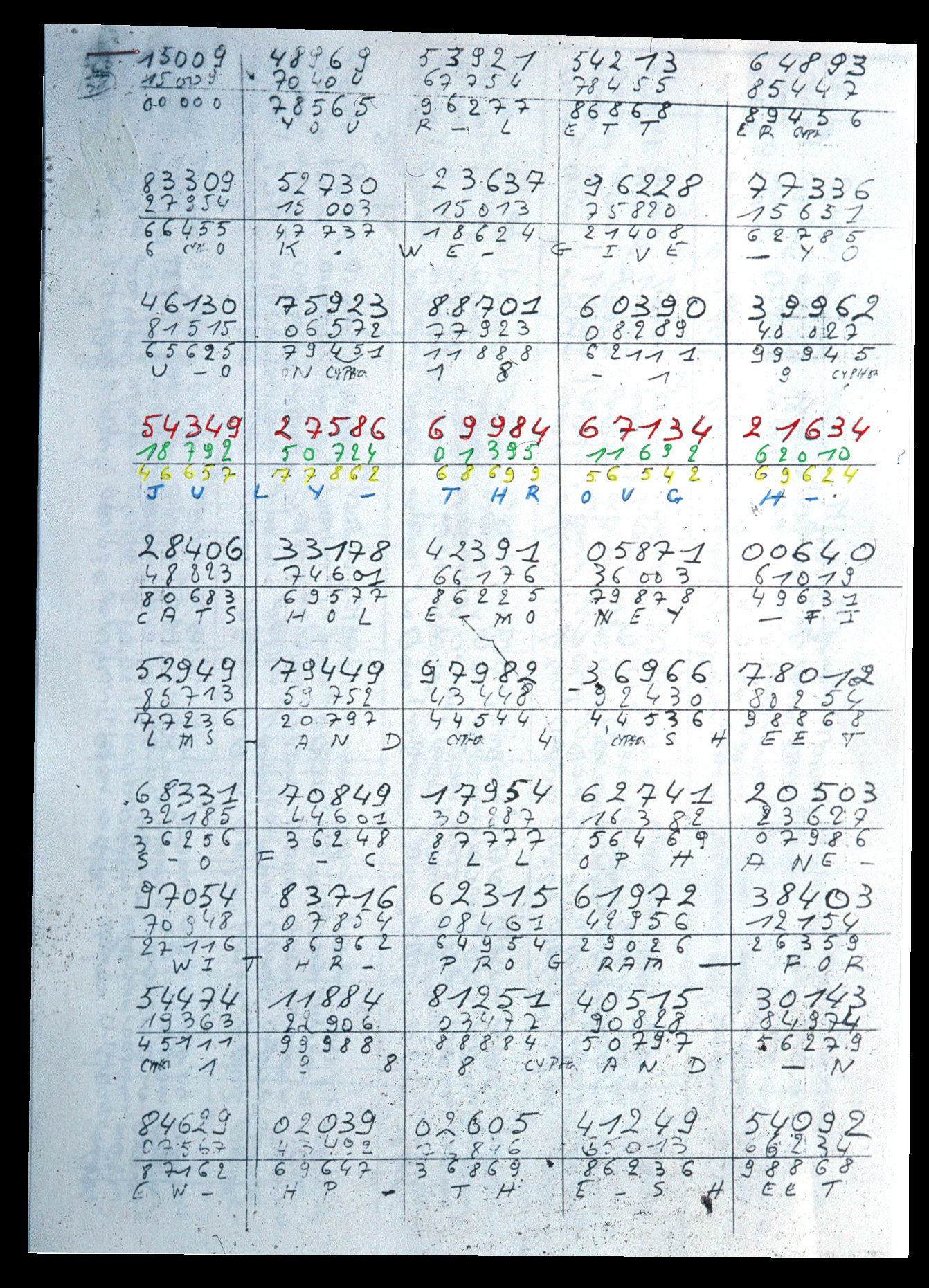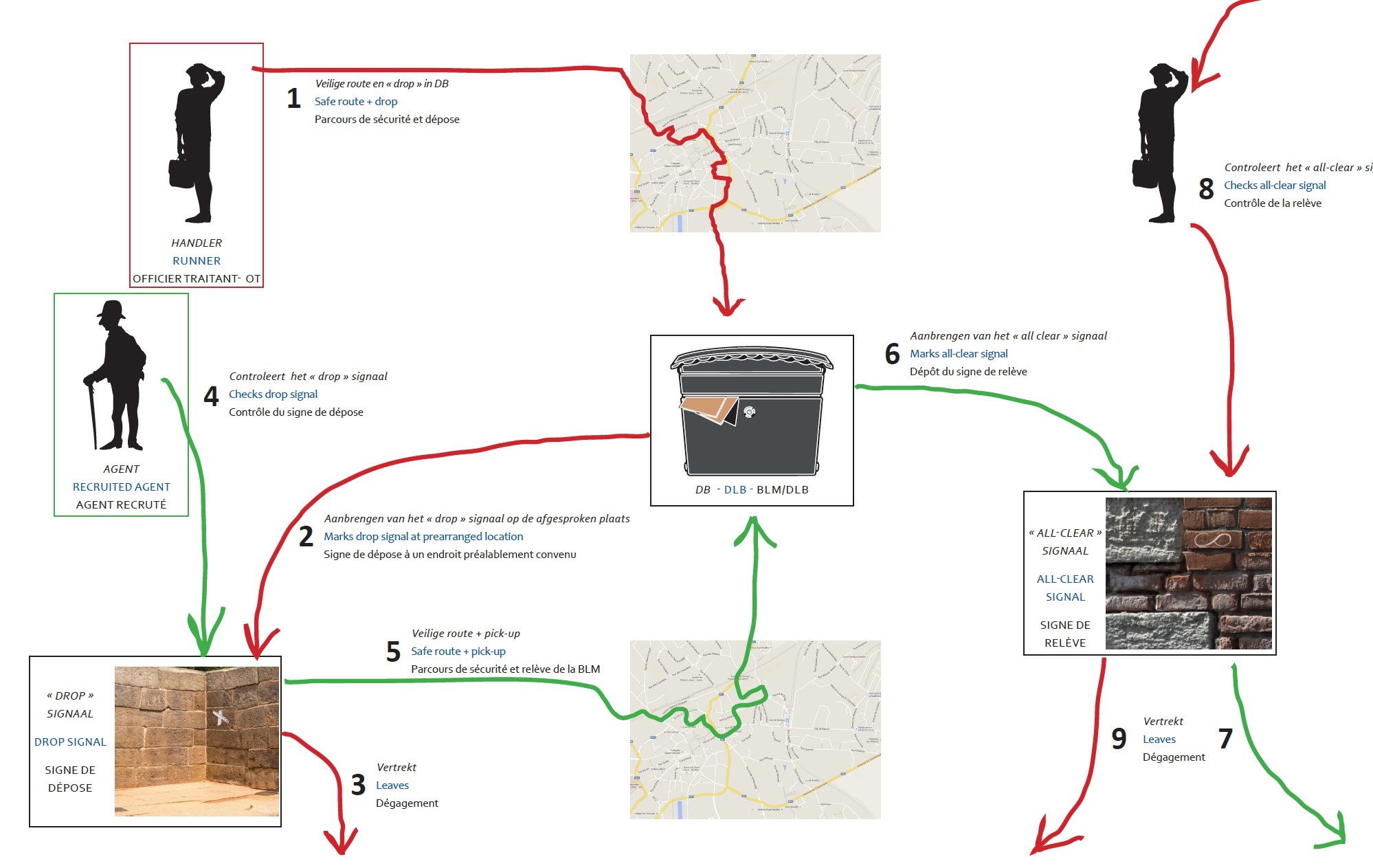| Previous page | Back to exhibition’s homepage | Next page |
| Contents: 1. Introduction 2. Binet’s briefcase 3. Radiocommunication between Binet and his clients 4. Dead letter box |
|
|
|
Introduction | Introduction | Inleiding |
| Le Lieutenant-colonel Binet, en service à la Force aérienne, tombe, début des années 80 dans le collimateur du service de renseignement militaire soviétique, le GRU (Glavnoje Razvedyvatelnoje Upralvlenije) alors qu’il fréquente des soirées culturelles et à thème organisées par les “Amitiés belgo-soviétiques”. C’est au cours de telles activités que le GRU essaie d’entrer en contact avec des personnes qui leur paraissent intéressantes. Au cours d’une de ces soirées, il est approché par un certain ‘Pjotr’, qui se présente comme l’adjoint de l’attaché militaire soviétique. En réalité, Pjotr est ‘spotterrecruteur’ pour le GRU. Le Lieutenant-colonel Binet, qui n’est pas pro-américain mais plutôt partisan d’un statu quo de la guerre froide, reste ouvert à la proposition de contacts ultérieurs. | In the early 1980s, Air Force Lieutenant Colonel Guy Binet got on the radar screen of the Soviet military intelligence agency – aka the GRU (Glavnoje Razvedyvatelnoje Upralvlenije) – after attending several cultural and theme evenings organised by the “Amitiés belgo-soviétiques”. On these occasions, the GRU used to make attempts at weaving ties with interesting people. During one of these events, Binet was approached by a certain “Pjotr”, who pretended to be the assistant of the Soviet military attaché. In reality, Pjotr was a “spotter-recruiter” for the GRU. Binet, who was not pro-American but rather advocated for a status quo in the Cold War, kept the door open for further contact. | Luitenant-kolonel Guy Binet, in dienst bij de Luchtmacht, komt begin jaren ’80 in het vizier van de Sovjet militaire inlichtingendienst, de GRU (Glavnoje Razvedyvatelnoje Upralvlenije) na het bijwonen van enkele thema- en culturele avonden georganiseerd door de “Amitiés belgo-sovétiques”. Bij deze gelegenheden probeert de GRU contact te leggen met interessante personen. Op één van deze avonden wordt Binet benaderd door een zekere ‘Pjotr’, die zich uitgeeft als adjunct van de Russische militaire attaché. In werkelijkheid is Pjotr een “spotter-recruteur” voor de GRU. Binet, die niet pro-Amerikaans is, en een voorstander is voor de bevriezing van de Koude Oorlog, staat open voor verdere contacten. |
| Alors qu’il est promu colonel avec comme responsabilité le budget de la Force aérienne, les Soviétiques tentent leur chance. Ils le confondent avec les photos de ses rencontres avec des personnalités soviétiques au cours des soirées à thème et expriment des menaces à l’encontre de sa famille. Le Lieutenant-colonel Binet se sent coincé et accepte de coopérer. Il rencontre à Vienne un des responsables du GRU, qui lui demande de fournir aux Soviétiques des documents de l’OTAN. | When he was promoted colonel responsible for the budget of the Air Force, the Soviets seized their chance. They confronted him with pictures of his contacts with Soviet bigwigs during the theme evenings, and uttered threats against his family. Binet felt cornered and agreed to collaborate. In Vienna, he met one of the high-ups of the GRU, who asked him to provide Soviets with NATO documents. | Wanneer hij bevorderd wordt tot kolonel met verantwoordelijkheid voor het budget van de Luchtmacht, grijpen de Sovjets hun kans. Ze confronteren hem met foto’s van zijn ontmoetingen met Sovjet-prominenten tijdens de thema-avonden en uiten bedreigingen aan het adres van zijn familie. Binet voelt zich in het nauw gedreven en stemt in om samen te werken. In Wenen ontmoet hij één van de toplui van de GRU, die hem vraagt NAVO-documenten te bezorgen aan de Sovjets. |
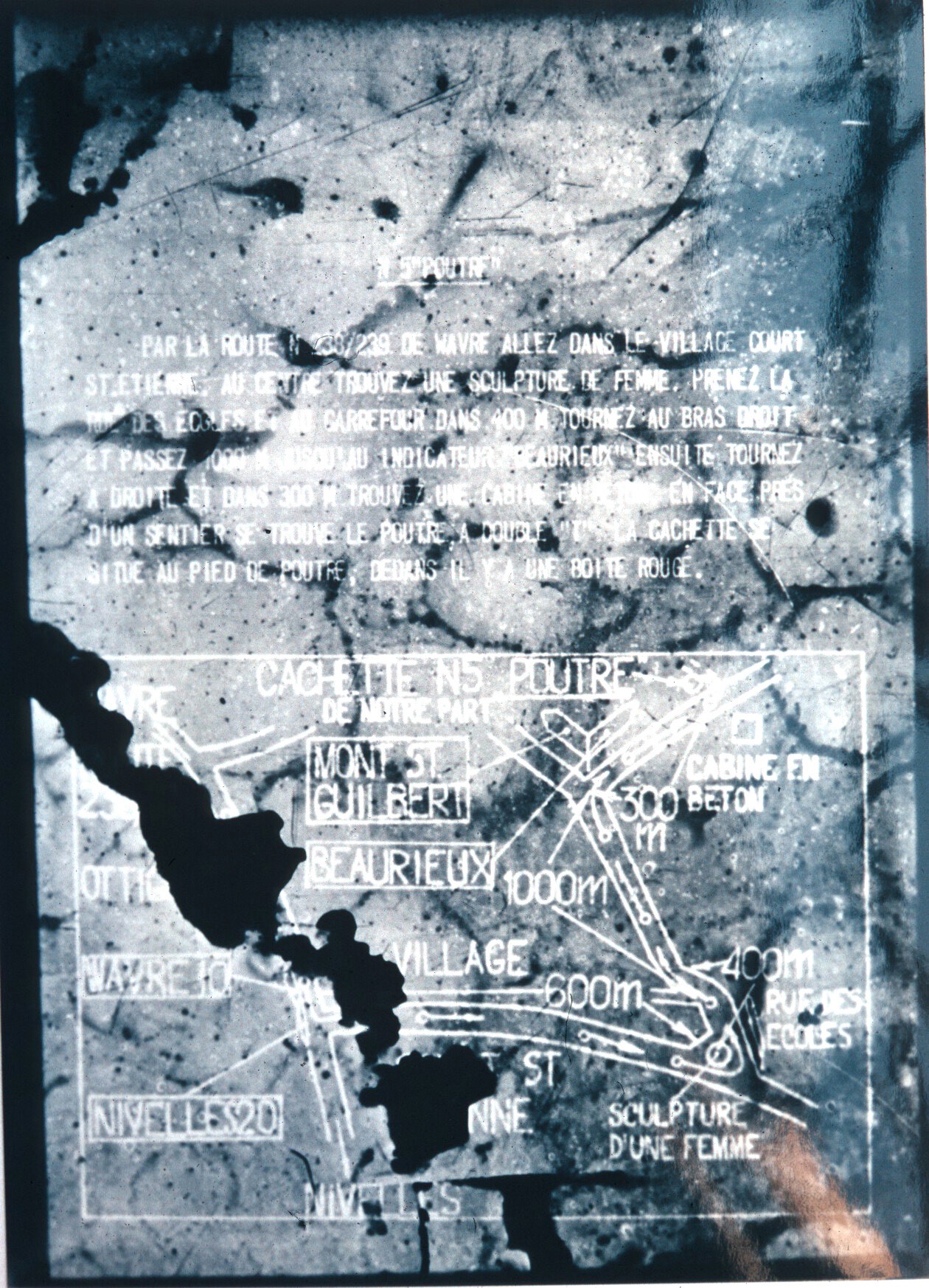 |  |
| La rencontre est observée par le renseignement militaire américain (Defense Intelligence Agency). Ils mettent au courant le contre-espionnage militaire belge de l’époque, la section SDRA III du SGR. Une équipe de recherches y est créée et après plus d’une année d’enquête et de filatures, le SGR confronte le Lieutenant-colonel Binet avec ses activités d’espionnage. A l’automne 1988, il est entendu et passe rapidement aux aveux complets. Le procès à huis clos débute en 1989. Le Lieutenant-colonel Binet est finalement condamné à 20 ans de travaux forcés et est dégradé. Binet est libéré anticipativement après 5 ans d’emprisonnement. Il a alors mené une vie dans l’anonymat jusqu’à son décès en 2000. | But the gathering was monitored by the American Defense Intelligence Agency. The latter alerted SDRA III – the then counterintelligence department of the Belgian military intelligence and security service (SGR) – to the situation. An investigation team was formed, and after more than a year of shadowing and investigation, the SGR confronted Binet with his espionage activities. In autumn 1988, Binet was heard and quickly made full confession. In 1989, the trial was held behind closed doors. Binet was ultimately sentenced to 20 years’ hard labour and military degradation. After 5 years’ imprisonment, Binet was granted early release and lived an anonymous life until his death in 2000. | De ontmoeting wordt echter vastgelegd door het Amerikaanse ‘Defense Intelligence Agency’. Deze stellen SDRA III, de toenmalige sectie contraspionage van de Belgische militaire inlichtingen- en veiligheidsdienst (SGR), hiervan op de hoogte. Er wordt een onderzoekteam opgericht en na een goed jaar van intensief schaduwen en onderzoeken, confronteert SGR Binet met zijn spionagewerk. In de herfst van 1988 wordt Binet verhoord en hij gaat snel over tot volledige bekentenissen. In 1989 gaat het proces achter gesloten deuren van start. Binet wordt uiteindelijk veroordeeld tot 20 jaar dwangarbeid en militaire degradatie. Binet komt na 5 jaar gevangenisstraf vervroegd vrij en leidt daarna een anoniem bestaan tot zijn dood in 2000. |
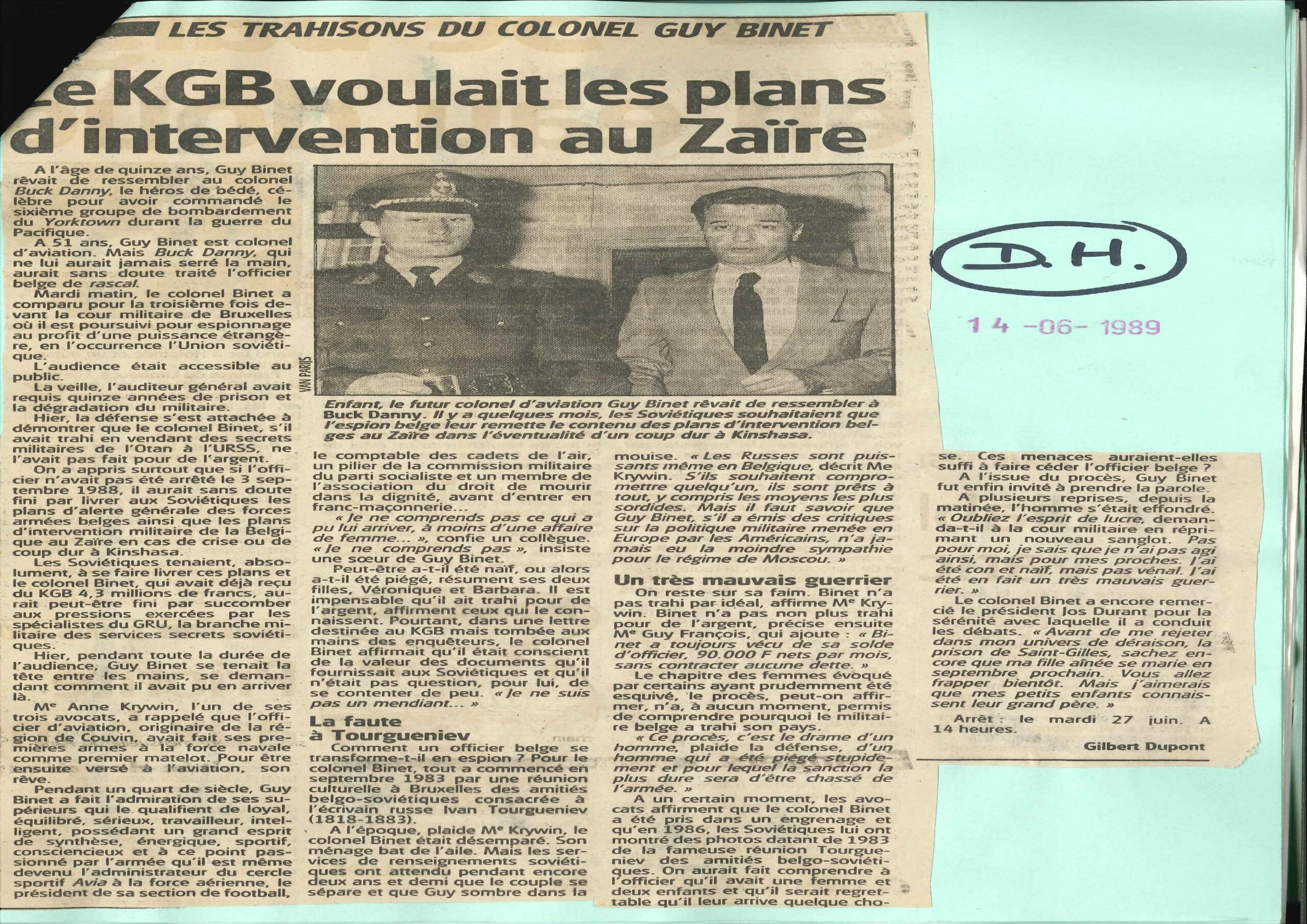 | 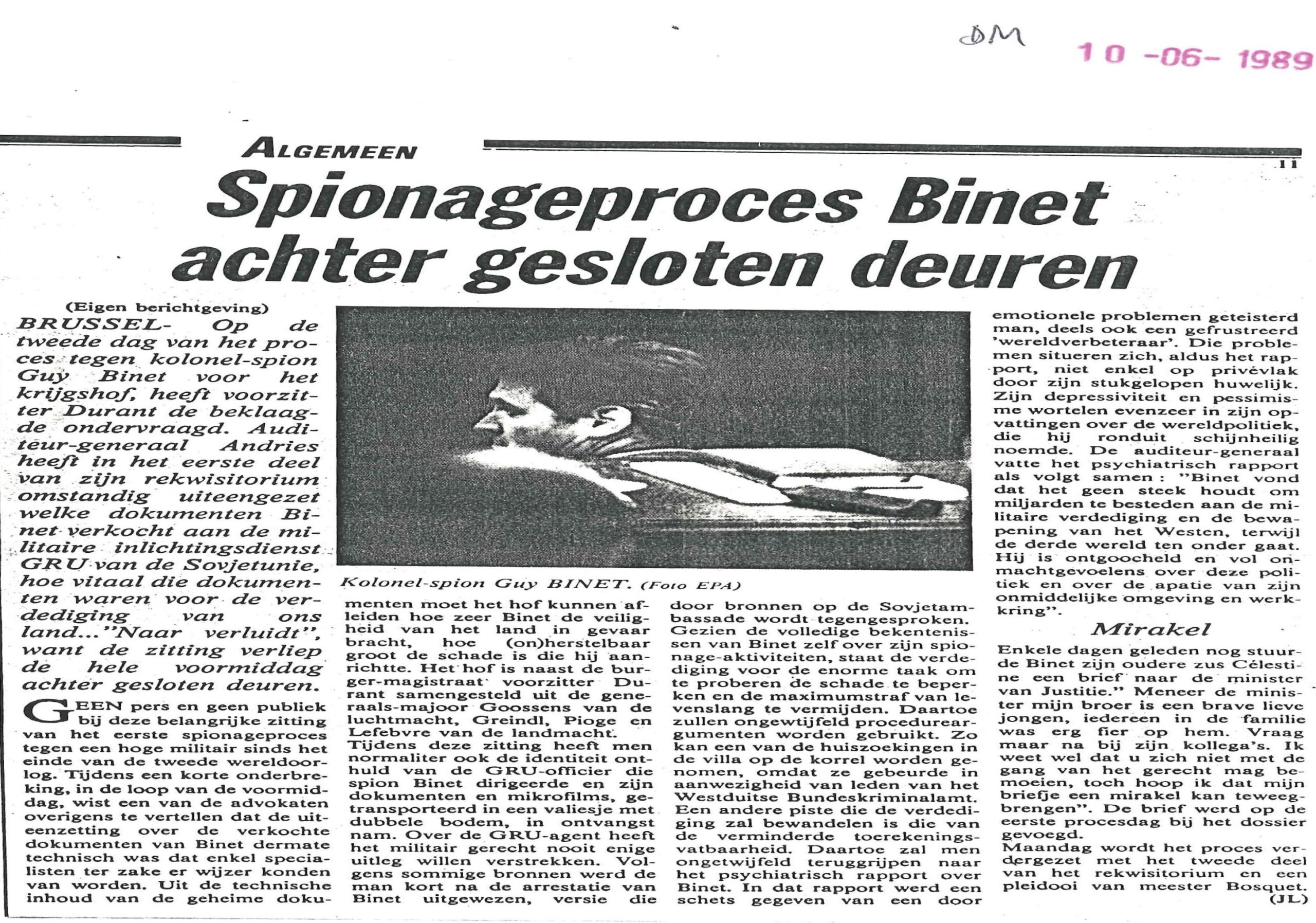 |
La mallette de Binet | Binet’s briefcase | De koffer van Binet |
| Binet rapporte chez lui des copies des documents qu’il veut remettre au GRU. Il photographie ensuite ces documents avec l’un des deux appareils MINOX fournis par le GRU. | Binet brings back home copies of documents that he wants to hand over to the GRU. He then takes pictures of these documents with one of the two MINOX cameras provided by the GRU. | Binet neemt kopieën van de documenten die hij aan de GRU wil overhandigen mee naar huis. Daar fotografeert hij de documenten met één van de twee MINOX-toestellen die hij van de GRU kreeg. |
| Pour faire sortir ces documents de l’État-major général sans se faire remarquer, Binet utilise une mallette à double fond. Le compartiment caché s’ouvre à l’aide d’un système simple mais ingénieux. | To smuggle the documents out of the General Staff without arousing suspicion, Binet uses a false-bottom briefcase. The secret compartment is opened using a simple, yet well thought-out system. | Om deze documenten ongemerkt de gebouwen van de Generale Staf buiten te smokkelen, gebruikt Binet een aktenkoffer met een dubbele bodem. De geheime bergplaats opent zich volgens een simpel maar uitgekiend systeem. |
| En effet, pour accéder au double fond, Binet se sert d’un trombone qui fait office de porte-clés pour la clé de la mallette. | To get access to the false bottom, Binet uses a paperclip that acts as a key ring for the key of the briefcase. | Om de dubbele bodem te openen, gebruikt Binet een papierklem die dienst doet als sleutelhanger voor de sleutel van de aktentas. |
Voilà comment Binet accédait au double fond.
This is how Binet could get access to his secret compartment.
Op deze manier kan Binet de dubbele bodem openen.
Communication radio entre Binet et ses commanditaires | Radiocommunication between Binet and his clients | Radiocommunicatie tussen Binet en zijn opdrachtgevers |
Listen to the Russian operator:
| Première ligne: Les pentagrammes (= groupe de 5 chiffres) notés par Binet en écoutant les communications radio. À cet effet, Binet a reçu un appareil radio du GRU, les messages codés lui sont transmis à certaines dates et heures. Si Binet venait à manquer une transmission, une date et une heure de réserve étaient prévues. | First line: The pentagrams (= group of five digits) written by Binet when listening to radio communications. To do so, Binet received a radio from the GRU. The encrypted messages were transmitted on a specific date and at a specific hour. Should Binet miss the initial message, a reserve date and hour were also provided. | Eerste lijn: De pentagrammen (= groep van vijf cijfers) die Binet noteerde bij het beluisteren van de radiocommunicatie. Hiervoor kreeg Binet een radio van de GRU. De gecodeerde boodschappen werden op bepaalde data en uren uitgezonden. Er werd steeds een reservedatum en uur voorzien, mocht Binet het initiële bericht gemist hebben. |
| Deuxième ligne: Dans la série suivante, on voit les pentagrammes provenant d’un tableau de décodage. Ce tableau était consigné sur un morceau de papier, dissimulé dans un marqueur. Au début de chaque transmission, Binet recevait un indice lui permettant de savoir quelle série de pentagrammes il devait utiliser. Après utilisation, Binet devait détruire la partie avec les pentagrammes utilisés. | Second line: The following series shows the pentagrams from a decoding table that was written on a little piece of paper hidden in a marker. At the beginning of every transmission, a clue allowed Binet to know what series of pentagrams he needed to use. Afterwards, Binet tore the used piece of paper and destroyed it. | Tweede lijn: Een volgende reeks pentagrammen die Binet van een decoderingstabel haalde. Deze decoderingstabel zat verstopt in een stift. Bij het begin van elk ontvangen bericht stond een indicatie welke reeks pentagrammen van de ontcijferingstabel Binet moest gebruiken. Na gebruik scheurde hij het stukje af en vernietigde het. |
| Troisième ligne: Différence entre les lignes 1 et 2, sans tenir compte des décimales. | Third line: Difference between line 1 and line 2, without taking decimals into account. | Derde lijn: Het verschil tussen lijn 1 en lijn 2, zonder rekening te houden met de decimalen |
| Quatrième ligne: Un code de conversion, inscrit sur un petit papier dans le portefeuille de Binet, permettait à ce dernier de convertir les chiffres en lettres. Ainsi, il obtenait un message compréhensible. | Fourth line: Thanks to a conversion code written on a paper in his wallet, Binet could convert digits into letters. He then obtained a readable message. | Vierde lijn: Aan de hand van de omzettingscode op een klein stukje papier uit Binet zijn portefeuille kon hij de getallen omzetten in letters. Op die manier kreeg hij een leesbare boodschap. |
Boîte aux lettres morte (BLM) | Dead letter box (DLB) | Dode brievenbus (DB) |
| Une BLM est une cache utilisée par un officier traitant (OT) et son agent pour se transmettre des instructions ou des documents sans se rencontrer. Elle se situe de préférence dans un lieu public dans lequel les deux personnes peuvent se rendre sans attirer l’attention. | A DLB is a cache used by a handler and his agent in order to pass instructions or documents without meeting each other. The cache is preferably located in a public area where both persons can go without arousing suspicion. | Een DB is een verstopplaats die wordt gebruikt door de handler en zijn agent om instructies of documenten door te geven aan elkaar, zonder elkaar te ontmoeten. De DB bevindt zich meestal in een publieke plaats waar de twee personen kunnen komen zonder aandacht te trekken. |
| Schéma | Scheme | Schema |
1. L’OT effectue un parcours de sécurité et remplit la BLM.2. L’OT laisse un signe de dépose à un endroit convenu préalablement.3. L’OT quitte la zone. 4. L’Agent contrôle le signe de dépose. 5. L’Agent effectue un parcours de sécurité et relève la BLM. 6. L’Agent dépose un signe de relève. 7. L’Agent quitte la zone. 8. L’OT contrôle le signe de relève. 9. L’OT quitte la zone. | 1. The handler takes a safe route and fills the DLB. 2. The handler leaves a “drop” signal at a prearranged location. 3. The handler leaves the area. 4. The agent checks if the “drop” signal is present. 5. The agent takes a safe route and empties the DLB. 6. The agent leaves an all-clear signal. 7. The agent leaves the area. 8. The handler checks if the all-clear signal is present. 9. The handler leaves the area. | 1. De handler volgt een veilige route en dropt iets in de DB. 2. De handler brengt een teken aan op een afgesproken plaats. 3. De handler verlaat de zone. 4. De agent checkt of het teken van de drop aanwezig is. 5. De agent volgt de veilige route en maakt de DB leeg. 6. De agent plaatst een teken dat de DB gelicht is. 7. De agent verlaat de zone. 8. De handler controleert het teken dat aangeeft dat de DB gelicht is. 9. De handler verlaat de zone. |
| Previous page | Back to exhibition’s homepage | Next page |
